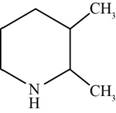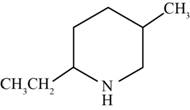
Concept explainers
Name the following:

(a)
Interpretation:
The given chemical structure has to be named.
Concept Introduction:
The nomenclature of the chemical structures:
A molecular formula describes the total number and types of the atoms in a molecule, whereas chemical structures describe the arrangement of atoms in a compound.
International Union of Pure and Applied Chemistry gave guidelines to write the chemical name of molecules. IUPAC names are totally different from common names because IUPAC names are applied at international level and it comprises suffix, prefix, numbers and other priority rules. The numbering starts from the side of substituent; if more than one substituent groups are present then these are cited alphabetically in the compound’s name.
Answer to Problem 21P
The name of the given compound is
Explanation of Solution
The structure of the given compound is shown below.

Figure 1
The compounds that comprise the saturated four membered rings are named as azetidines. The methyl substituent is present at the second carbon atom. Therefore, the name of the compound shown in figure is
(b)
Interpretation: The given chemical structure has to be named.
Concept Introduction:
The nomenclature of the chemical structures:
A molecular formula describes the total number and types of the atoms in a molecule, whereas chemical structures describe the arrangement of atoms in a compound.
International Union of Pure and Applied Chemistry gave guidelines to write the chemical name of molecules. IUPAC names are totally different from common names because IUPAC names are applied at international level and it comprises suffix, prefix, numbers and other priority rules. The numbering starts from the side of substituent; if more than one substituent groups are present then these are cited alphabetically in the compound’s name.
Answer to Problem 21P
The name of the given compound is
Explanation of Solution
The structure of the given compound is shown below.

Figure 2
The compounds that comprise the saturated six membered rings with a nitrogen atom are named as piperidines. The methyl substituents are present at the second and third carbon atoms. Therefore, the name of the compound shown in figure 2 is
(c)
Interpretation: The given chemical structure has to be named.
Concept Introduction:
The nomenclature of the chemical structures:
A molecular formula describes the total number and types of the atoms in a molecule, whereas chemical structures describe the arrangement of atoms in a compound.
International Union of Pure and Applied Chemistry gave guidelines to write the chemical name of molecules. IUPAC names are totally different from common names because IUPAC names are applied at international level and it comprises suffix, prefix, numbers and other priority rules. The numbering starts from the side of substituent; if more than one substituent groups are present then these are cited alphabetically in the compound’s name.
Answer to Problem 21P
The name of the given compound is
Explanation of Solution
The structure of the given compound is shown below.

Figure 3
The compounds that comprise the unsaturated four membered rings with a nitrogen atom are named as pyrroles. The chlorine substituent is present at the third carbon atom. Therefore, the name of the compound shown in figure 3 is
(d)
Interpretation:
The given chemical structure has to be named.
Concept Introduction:
The nomenclature of the chemical structures:
A molecular formula describes the total number and types of the atoms in a molecule, whereas chemical structures describe the arrangement of atoms in a compound.
International Union of Pure and Applied Chemistry gave guidelines to write the chemical name of molecules. IUPAC names are totally different from common names because IUPAC names are applied at international level and it comprises suffix, prefix, numbers and other priority rules. The numbering starts from the side of substituent; if more than one substituent groups are present then these are cited alphabetically in the compound’s name.
Answer to Problem 21P
The name of the given compound is
Explanation of Solution
The structure of the given compound is shown below.

Figure 4
The compounds that comprise saturated six membered rings with a nitrogen atom are named as piperidines. The ethyl and methyl substituents are present at the second and fifth carbon atoms respectively. Therefore, the name of the compound shown in figure is
Want to see more full solutions like this?
Chapter 19 Solutions
Organic Chemistry (8th Edition)
- Highlight each glycosidic bond in the molecule below. Then answer the questions in the table under the drawing area. HO- HO- -0 OH OH HO NG HO- HO- OH OH OH OH NG OHarrow_forward€ + Suppose the molecule in the drawing area below were reacted with H₂ over a platinum catalyst. Edit the molecule to show what would happen to it. That is, turn it into the product of the reaction. Also, write the name of the product molecule under the drawing area. Name: ☐ H C=0 X H- OH HO- H HO- -H CH₂OH ×arrow_forwardDraw the Haworth projection of the disaccharide made by joining D-glucose and D-mannose with a ẞ(1-4) glycosidic bond. If the disaccharide has more than one anomer, you can draw any of them. Click and drag to start drawing a structure. Xarrow_forward
- Epoxides can be opened in aqueous acid or aqueous base to produce diols (molecules with two OH groups). In this question, you'll explore the mechanism of epoxide opening in aqueous acid. 2nd attempt Be sure to show all four bonds at stereocenters using hash and wedge lines. 0 0 Draw curved arrows to show how the epoxide reacts with hydronium ion. 100 +1: 1st attempt Feedback Be sure to show all four bonds at stereocenters using hash and wedge lines. See Periodic Table See Hint H A 5 F F Hr See Periodic Table See Hintarrow_forward03 Question (1 point) For the reaction below, draw both of the major organic products. Be sure to consider stereochemistry. > 1. CH₂CH₂MgBr 2. H₂O 3rd attempt Draw all four bonds at chiral centers. Draw all stereoisomers formed. Draw the structures here. e 130 AN H See Periodic Table See Hint P C Brarrow_forwardYou may wish to address the following issues in your response if they are pertinent to the reaction(s) you propose to employ:1) Chemoselectivity (why this functional group and not another?) 2) Regioselectivity (why here and not there?) 3) Stereoselectivity (why this stereoisomer?) 4) Changes in oxidation state. Please make it in detail and draw it out too in what step what happens. Thank you for helping me!arrow_forward
- 1) Chemoselectivity (why this functional group and not another?) 2) Regioselectivity (why here and not there?) 3) Stereoselectivity (why this stereoisomer?) 4) Changes in oxidation state. Everything in detail and draw out and write it.arrow_forwardCalculating the pH at equivalence of a titration 3/5 Izabella A chemist titrates 120.0 mL of a 0.7191M dimethylamine ((CH3)2NH) solution with 0.5501 M HBr solution at 25 °C. Calculate the pH at equivalence. The pk of dimethylamine is 3.27. Round your answer to 2 decimal places. Note for advanced students: you may assume the total volume of the solution equals the initial volume plus the volume of HBr solution added. pH = ☐ ✓ 18 Ar Boarrow_forwardAlcohols can be synthesized using an acid-catalyzed hydration of an alkene. An alkene is combined with aqueous acid (e.. sulfuric acid in water). The reaction mechanism typically involves a carbocation intermediate. > 3rd attempt 3343 10 8 Draw arrows to show the reaction between the alkene and hydronium ion. that 2nd attempt Feedback 1st attempt تعمال Ju See Periodic Table See Hint F D Ju See Periodic Table See Hintarrow_forward
- Draw the simplified curved arrow mechanism for the reaction of acetone and CHgLi to give the major product. 4th attempt Π Draw the simplified curved arrow mechanism T 3rd attempt Feedback Ju See Periodic Table See Hint H -H H -I H F See Periodic Table See Hintarrow_forwardSelect the correct reagent to accomplish the first step of this reaction. Then draw a mechanism on the Grignard reagent using curved arrow notation to show how it is converted to the final product. 4th attempt Part 1 (0.5 point) Select the correct reagent to accomplish the first step of this reaction. Choose one: OA Mg in ethanol (EtOH) OB. 2 Li in THF O C. Li in THF D. Mg in THF O E Mg in H2O Part 2 (0.5 point) Br Part 1 Bri Mg CH B CH, 1 Draw intermediate here, but no arrows. © TE See Periodic Table See Hint See Hint ין Harrow_forwardSelect the product for the following reaction. HO HO PCC OH ○ OH O HO ○ HO HO HOarrow_forward

 Chemistry for Today: General, Organic, and Bioche...ChemistryISBN:9781305960060Author:Spencer L. Seager, Michael R. Slabaugh, Maren S. HansenPublisher:Cengage Learning
Chemistry for Today: General, Organic, and Bioche...ChemistryISBN:9781305960060Author:Spencer L. Seager, Michael R. Slabaugh, Maren S. HansenPublisher:Cengage Learning ChemistryChemistryISBN:9781305957404Author:Steven S. Zumdahl, Susan A. Zumdahl, Donald J. DeCostePublisher:Cengage Learning
ChemistryChemistryISBN:9781305957404Author:Steven S. Zumdahl, Susan A. Zumdahl, Donald J. DeCostePublisher:Cengage Learning Chemistry: An Atoms First ApproachChemistryISBN:9781305079243Author:Steven S. Zumdahl, Susan A. ZumdahlPublisher:Cengage Learning
Chemistry: An Atoms First ApproachChemistryISBN:9781305079243Author:Steven S. Zumdahl, Susan A. ZumdahlPublisher:Cengage Learning




